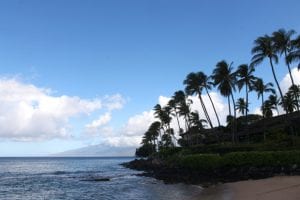Whether you’re looking to be pampered or crave an adventure vacay, Hawaii’s low-key paradise offers what you need

ARNOLD WAYNE JONES | Executive Editor
If you saw the recent news about two hurricanes bearing down simultaneously on the Hawaiian Islands, you might have thought how scary and vulnerable it feels to be in the middle of the ocean on a small spit of land, thousands of miles from a continent. But then the storms turned out to be tempests in a teacup, and once again Hawaii returns to its vaunted position as a genuine American paradise. You don’t need a passport, just a desire to relax on a island getaway.
And while The Big Island is, well, bigger, and Oahu is more populated, Maui is sort of the Goldilocks of this Pacific archipelago: Not too large, not too small; not too remote, not too touristy. As one resident told me, “Maui is the perfect place to do everything … or do nothing.”
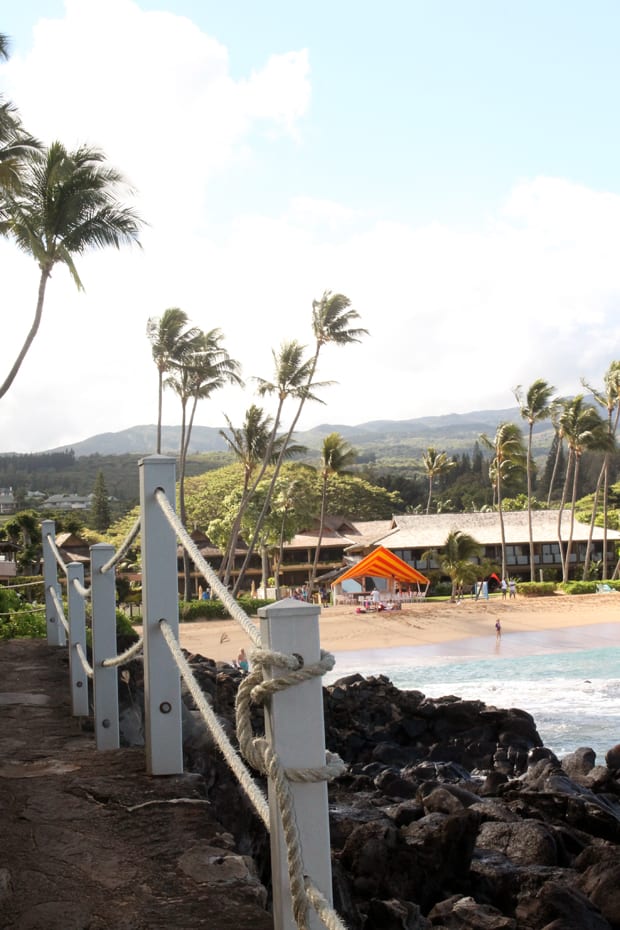
An oceanside walkway connects the rooms of the historic Napili Kai resort with its crescent-shaped beach and famed Sea House restaurant. (Photo by Arnold Wayne Jones)
That triggered the realization that we each have different expectations on vacation. Some of us want to decompress and be pampered by experts. Some of us want to engage in the culture and do as much for ourselves as we can (that’s often less expensive, as well). So here it is: Maui, the place to go to veg… or live it up. Season to taste.
Maui, shaped roughly like a figure 8, is small enough that you could feasibly spend one full day and drive around its perimeter and up to the top of the Haleakala mountain and still get home before sunset. But despite its manageable size, it’s made up of neighborhoods and destinations, each of which offers unique advantages. There are any number of different combinations that you could explore — from beachside resorts and spas to condo rentals to Air BnB to luxury hotels to all inclusive resorts. The variety makes it easy to tailor your vacation … the hard part is deciding what to do first.
You can, of course, mix it up, but there’s no need to; you can always just pick one or the other and do that for the full length of your trip.
Pampered
South Maui — notable for the Wailea/Makena communities — is the high-end resort destination. Developed mostly in the 1970s, it’s flush with golf courses and roomy, glamorous seaside hotels. Although all beaches in Hawaii are public, you feel as if you are entering a gated community, where shaded drives take you to open-air lobbies of spacious hotels manned by friendly staffs. The Grand Wailea — massive, and the oldest of the resorts — neighbors the Marriott and the Andaz (the newest hotel) to the west, and the Four Seasons and the Fairmont Kea Lani to the east. All will take good care of you.
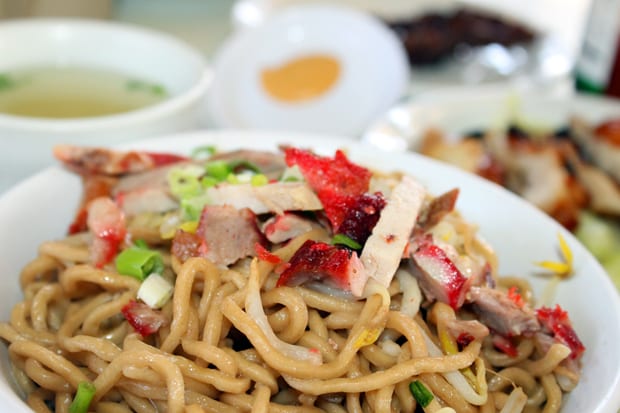
LET’S HAVE A KIKI | The cuisine on Maui, especially traditional ‘ko’ plantation style such as the kind available from Sam Sato, above, is distinctive; below, an amazing dessert from the landmark Mama’s Fish House. (Photos by Arnold Wayne Jones)
The Kea Lani boasts all-suite accommodations, and is boutique in size compared to some of the larger hotels, but the amenities are amazing: Personalized Le Labo toiletries, all-beach views from the spacious balconies and an attentive concierge desk — they give you a cell number to which you can text requests, such as having your car brought around. But if you’re staying in the area, you won’t need your car much: There’s also an oceanside footpath, popular as well with joggers, that links all of the resorts, and the Kea Lani’s complimentary shuttle service will drop you off at any neighboring property, take you to the golf course (including its signature restaurant, Gannon’s, established by former Dallasite and legendary Maui chef Bev Gannon) and even the Shops at Wailea, a high-end hacienda-like mall.
You might head over to the Shops for casual dining at the longstanding Cheeseburger Grill & Tap Room, which serves a wide selection of pub grub, brews and mai tais; or check out the newer Pint & Cork, a late-night speakeasy-style bar and gastropub with comfort food sourced locally. The Pint & Cork is probably one of the fewer places open late in this area of Maui; the theme is relaxation and slowing down. Attend, though, in the summer, and you can enjoy an amazing outdoor tradition: The Maui Film Festival, which screens new films with celebrity guests (this year included honorees Bryan Cranston, Viola Davis and Michael B. Jordan) in what they call Celestial Cinema: A huge screen on the golf course, where movies run only after the sun goes down. It captures the perfect vibe of the area as a place to chill.
There is no more chill area of Maui, though, than the town of Hana on the East Side. Only 40 miles from the airport, it’s accessible only by the Hana Highway, a magnificent coastal drive with breathtaking vistas. It’s slow going — not just because most bridges don’t permit two-way traffic (you can’t be aggressive in your driving), but also because you’ll want to stop frequently: To soak in the views, take photos, or even enjoy fresh lilikoi juice, coconut candy or sugar cane from the roadside fruit stands.
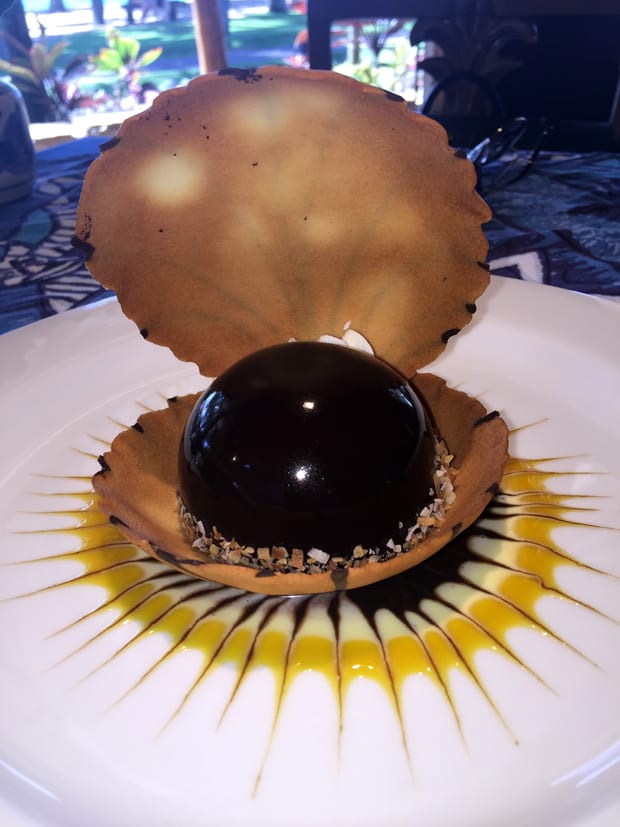 While in Wailea/Makena, you can stay put at your hotel (the Kea Lani offers both family and adult-centric pools, including a swim-up bar, as well as on-site beach access), and even get a little exercise and sightseeing taken care of at once with an outrigger canoe lesson — one of the great pleasures of a trip is whale watching and looking for sea turtles — or you can venture a little farther down the coastline for Big Beach/Little Beach. A shady enclave opens into a pale-sand strip called Big Beach, or you can climb over the outcropping of lava to more adult-focused Little Beach, which is clothing-optional, co-ed and very popular with the many gay residents of the island. (More than one told me a typical Sunday would be a towel, umbrella and cooler for the afternoon; later in the day, drummers show up for impromptu jam sessions.)
While in Wailea/Makena, you can stay put at your hotel (the Kea Lani offers both family and adult-centric pools, including a swim-up bar, as well as on-site beach access), and even get a little exercise and sightseeing taken care of at once with an outrigger canoe lesson — one of the great pleasures of a trip is whale watching and looking for sea turtles — or you can venture a little farther down the coastline for Big Beach/Little Beach. A shady enclave opens into a pale-sand strip called Big Beach, or you can climb over the outcropping of lava to more adult-focused Little Beach, which is clothing-optional, co-ed and very popular with the many gay residents of the island. (More than one told me a typical Sunday would be a towel, umbrella and cooler for the afternoon; later in the day, drummers show up for impromptu jam sessions.)
Independent
West Maui is the more do-it-all-yourself side of the island. Anchored by the town of Lahaina, which has a bustling traffic flow similar to any small town you might encounter, it’s dotted not just with hotels, but also strip malls and private homes; fine-dining and fast-food options; grocery stores and farmers’ markets; general stores, fashion boutiques and surf-and-sand shops for beachwear and trinkets. But the tone is less touristy, with more of a “this is where the locals hang” vibe.
That’s similarly true at the historic Napili Kai Beach Resort. With its crescent beach along a protected bay, it feels more like living in your own apartment than renting a hotel room. You can park just outside your door, and leave a sign on the knob to let housekeeping know when you want them to come by, rather than shoo them off when it’s occupied.
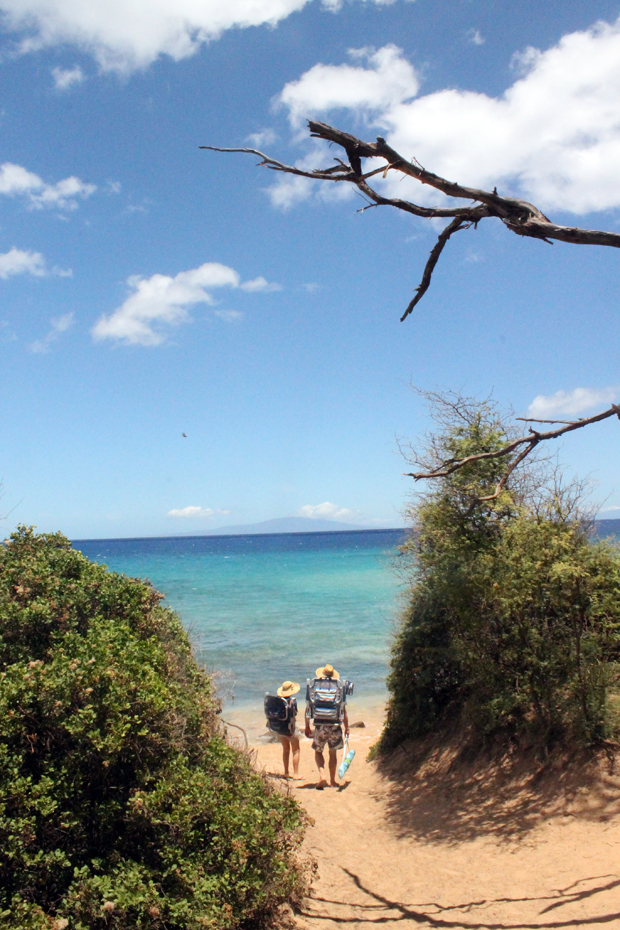
Little Beach in Makena is a bit of a hike, but its clothing-optional policy makes it popular with the gay community; below, the bronze gate at the Maui Arts and Cultural Center is patterned after nets familiar to local fishermen. (Photos by Arnold Wayne Jones)
I relished the independence — no need for turndown service, room service, or any of the froufrou amenities of the Kea Lani. The refrigerator was full-sized, we had a dishwasher, microwave, large coffee pot, toaster and washer-dryer facilities. It’s easy to stock up of supplies and cook for yourself (including a few mixed drinks) and run a load of clothes while taking a dip in semi-private pool. An outdoor grill even lets you throw some salmon, steak or shrimp on the barbie. It’s the kind of resort that you want to come back to again and again.
There are tremendous views from most rooms, with the island of Lana’i beckoning in front of you, and Molokai to the right. The on-site restaurant, The Sea House, has been a staple here for more than 50 years — in fact, most of this part of Maui was developed just after Hawaii became a state. It’s the older, more settled area of Maui, and feels lived in. It’s also wetter, getting more rainfall than other areas, which ensconces you in the old-growth forests and greenery.
You’ll definitely want a car on this side of the island, though, as the area isn’t as compact as South Maui, especially if you don’t want to cook for yourself. In addition to the Sea House — where executive chef Alex Stanislaw conjures up some elegant surf (as well as turf) dishes, for breakfast, lunch and dinner — there are countless restaurants in West Maui that provide unexpected delights. Among them: Sangrita. You might not consider going from Texas to Hawaii for tacos, ceviche and burritos, but this marvelous cantina from respected chef/owner Paris Nabavi serves some of the best guacamole I’ve ever eaten, as well as top-notch queso fundido, intoxicating desserts (including corn flan and Maui-made gelato) and an enviable stock of tequila.
Further to the tip of the island is Taverna Kapalua, an Italian bistro in the heart of the Pacific. Gourmet pizzas (and no pineapple!), deftly seasoned raviolis and a winning wine list make this newcomer on the Maui culinary scene a go-to spot.
For old-school food, drive over to Central Maui, at the mouth of the Hana Highway, to experience the one unmissible dining tradition: A visit to Mama’s Fish House. In the same locale since the 1970s, this landmark is also an elegant boutique inn with gorgeous and comfy décor, full kitchens and the quickest possible access to the restaurant. The menu is updated daily with the fish brought in that morning (with ono and mahi-mahi popular dishes). The huge operation still manages to deliver lovely handcrafted entrées (even a “mini-luau on a platter”) and desserts.
Experience ko
Hawaiian culture is actually an amalgam of many other cultures: Chinese, Japanese, Polynesian, Portuguese and more. That cross-section — which no doubt contributes largely to the liberal, accepting, live-and-let-live attitude that makes Hawaii such a welcoming destination for queer travelers — is expressed in the concept of ko. Migrants from all over the world worked the sugar plantations and exchanged their culinary traditions with each other. The plantations themselves are completely gone now, but plantation- inspired food is still one of the richest traditions on Maui.
 The Kea Lani’s fine-dining restaurant Ko reflects this style in a sophisticated ways (try the chana-style pupu tray for a sampling). The hearty bouillabaisse of clams, lobster and fresh fish reminds you why you came to an island in the first place. Wash it all down with a tropical selection of craft cocktails. (If anyone says “pau hana” to you, just agree immediately — it means “let’s meet for drinks after work,” i.e., happy hour.)
The Kea Lani’s fine-dining restaurant Ko reflects this style in a sophisticated ways (try the chana-style pupu tray for a sampling). The hearty bouillabaisse of clams, lobster and fresh fish reminds you why you came to an island in the first place. Wash it all down with a tropical selection of craft cocktails. (If anyone says “pau hana” to you, just agree immediately — it means “let’s meet for drinks after work,” i.e., happy hour.)
On the less fancy end of ko, Sam Sato’s in Wailuku in Central Maui offers up traditional and inexpensive dishes such as saimin (noodle soup), chow fun (beef stir fry), loko moko (a beef patty or Spam, over fried rice and topped with an egg) and some tasty fruit turnovers.
An amazing variation of ko cuisine is at the hard-to-find new storefront diner Tin Roof. Founded by Top Chef fan favorite Sheldon Simeon — formerly the exec chef at famed Star Noodle — it’s a hole-in-the-wall par excellence, with rice bowls of pork belly, mochiko chicken and spicy street food that’s simply magical.
Explore
If you want to explore the island at your own pace, there are countless activities for such an intimate island. The Upcountry is dominated by Haleakala National Park, which starts at the foot of the Haleakala volcano (like all the islands, Maui is the result of accretion at the top of volcano; only The Big Island, home to Mauna Loa and Mauna Kea, still has active lava flows) and shoots up more than 10,000 feet above sea-level. (Measured from its base at the bottom of the ocean, Haleakala would be taller than Mount Everest.) Many visitors take part in a sunrise or sunset bike trip up or down the mountain, though it’s a dizzying if gorgeous experience to tower over the ocean.
Although the rental car companies officially prohibit it, the Hana Highway effectively continues across the far southeast side of the island, which displays a landscape unlike any other. The so-called Seven Sacred Pools, technically part of the national park, is a walkable and tourist-popular attraction, but continue clockwise to see one of the driest areas on the planet, and stop by the small farms and shops selling everything from wine to honey.
You can soar overhead on zipline tours, or go below the surface by signing up for an underwater snorkeling trip. From Central Maui, a harbor offers numerous trips, including a four-hour sail-and-dive to Molokini, a submerged half-moon crater and host to countless fauna, including schools of humuhumnukunukuapua’a, the tiny reef triggerfish that is the official fish of the state.
It’s also easy to employ helicopter rides that go over (and sometimes land on) other islands, or book day trips to Molokai or Oahu But really, there’s no reason to leave Maui. Every day away is merely paradise lost.




